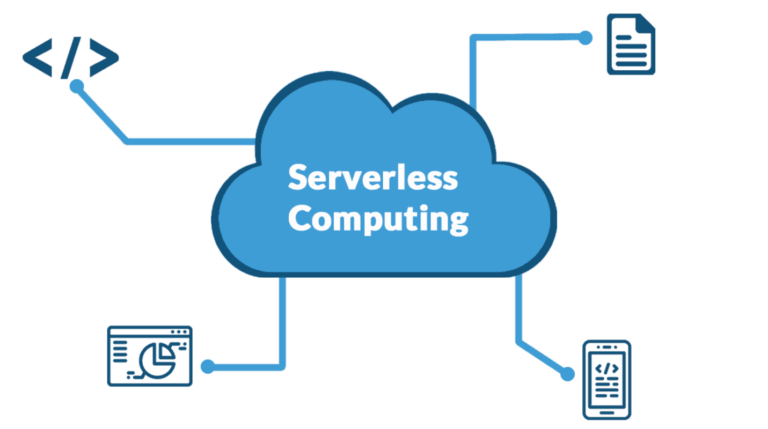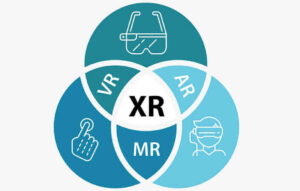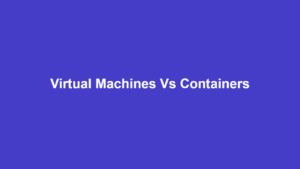Serverless Computing: Key features and how it works

Serverless computing is a unique approach to hosting web applications that takes all the server management work away, allowing builders to do what they know best.
Flexibility, ease of management, ease of scaling, and lower costs are some of the highlights that make serverless computing very attractive for dev teams and companies.
A serverless computing environment runs server-side code on demand, and without needing a dedicated server, virtual machine, or even a container in constant operation.
This post explores the world of serverless computing to show how it can benefit your company or next project.
How Does Serverless Computing Work?
A serverless service is a computing environment that is completely managed by the service provider. All a developer has to do is create his function and upload it to the platform, and then everything is handled automatically. Here’s how it goes.
- Trigger: Every serverless function has an event trigger that calls it into action. It could be an HTTP or database request, cron job, file upload, or whatever. The point is that everyone knows what needs to happen for the script to execute.
- Resource Allocation: If the expected event/trigger occurs, then it’s up to the platform to quickly spin up an execution environment with CPU, memory, and networking within milliseconds. This is usually accomplished with containers.
- Function Execution: The platform transfers execution to the script after resource allocation, so the application can now execute in the service provider’s execution environment.
- Scaling: If there is a need for more resources, then the system will scale automatically, by spinning up more containers with the application to balance the load.
- Results & Management: Depending on the provider and service, different tasks, results, responses, monitoring, and logging processes can go on. Used resources are also recorded for the pay-as-you-go billing.
Key Features Of Serverless Systems
There are certain features that most serverless computing platforms share with one another, irrespective of their other differences. So, to better understand serverless computing, here are these key features.
- Cloud-Based: Serverless computing is a cloud-native application development and deployment technology.
- Zero Server Management: A serverless computing platform makes it easy for users to develop and deploy apps without having to manage servers. Simply upload your code and everything else is automatically taken care of.
- Event/Trigger Driven: Unlike virtual machines and container services, serverless systems are not always running. Rather, they are only activated whenever they are needed by an event or trigger.
- Pay-As-You-Go: Serverless computing only uses resources when triggered. This makes them cheaper to run than containers, which always need to be active, whether they are used or not. Hence, serverless services are billed by usage in a pay-as-you-go format.
- Auto Scaling: The serverless platform will automatically scale resource allocation to an application up or down to balance its load demands.
- Stateless By Default: Most serverless platforms are stateless by default, meaning that they do not store any data between invocations. This feature makes them ephemeral and ideal for the asynchronous programming approach of handling multiple tasks at once.
The Business Benefits of Serverless Computing
Here are some of the business benefits of serverless computing.
- Simplified Development: There is no need to manage infrastructure. No server configuration, no environments, no budgets, and nothing to set up. All you need to do is focus on your app development and your serverless platform will take care of the rest.
- Faster Time To Market: Spending less time on infrastructure management enables your team to develop and bring more features and applications to market.
- Cost Efficiency: Serverless systems are perfect for applications that are not constantly used. This way, you save costs that would have gone into maintaining a constantly available server or container.
- Auto Scaling: No need to worry about budgeting for managing server loads. Your application is automatically scaled and you only get billed for what you used.
Serverless Vs Containers
Serverless computing and containerization are two cloud-native technologies that allow you to save costs, deploy applications quickly and reliably, automate your operations, and easily scale things if the need arises.
Though they serve seemingly similar purposes, containers and serverless systems are different. First, the developer needs to start and maintain a container that provides his execution environment, while the service provider does all of that in serverless setups.
Second, containers are better suited for larger applications, which need to run for extended amounts of time, while serverless is better for smaller apps that are not used often. Furthermore, containers offer complete control of the execution environment, while serverless offers little or no environmental controls.
Finally, containers are portable, as you can take your container from one provider to the other without any issues, while serverless apps can suffer from vendor lock-in, as each vendor’s execution environment is unique.
Serverless Vs FaaS Vs BaaS
Another group of similar but different terms are serverless, FaaS, and BaaS. FaaS stands for Function as a Service, while BaaS stands for Backend as a Service. Both technologies are subsets of serverless, but they differ in approach.
Function as a Service is the term mostly associated with serverless computing. It is a system where the provider offers all the resources needed to execute an application in the cloud. FaaS applications are usually specific to a programming language and often perform a single, specific action with each invocation.
Backend as a Service, on the other hand, includes all the services that a cloud-based app needs to function. These can include hosting, database services, authentication services, scalability, and so on. BaaS services also remove the need for servers, virtual machines, and container management, just like FaaS.
Types of Serverless Systems & Industry Applications
Serverless technology provides most of the computing functions that users require in a cloud environment without the need to manage their underlying infrastructure. Following are some of the many ways that these serverless services are offered.
- FaaS (Function as a Service): From PHP to JavaScript or GO functions, many providers offer different FaaS packages for different languages that will also scale automatically.
- BaaS (Backend as a Service): From Netlify to AWS Amplify, Firebase, AppWrite, and a host of others, backend-as-a-service makes it easy to develop specific types of web apps.
- Static Web Hosting: Static websites don’t need a backend server like PHP and MySQL. They just serve pre-rendered HTML and JavaScript files, making them easy and cheap to maintain. They are also the fastest-loading sites and great for SEO.
- Streaming Data Processing: Serverless applications are ideal for streaming data processing, as they can scale as needed and are perfect for all types of real-time analysis.
- Mobile & Web Apps: Sparsely used mobile and web apps will equally benefit a lot from serverless deployments.
- Databases: Database applications with variable or unpredictable loads can equally leverage the many benefits of serverless computing.
- Micro-Services & APIs: Serverless systems are the ideal platform for developing and deploying micro-services and APIs with unpredictable demand.
- On-demand/Event-Driven Processes: Any non-steady event that needs processing will benefit from serverless.
- IoT Apps: Internet of Things applications with their small payload and other minimal requirements will do well connecting with serverless applications.
- Cron/Scheduled Tasks: Another great opportunity for serverless.
- Asynchronous Tasks & Batch Processing: A stateless, serverless environment is equally ideal for handling asynchronous tasks and batch processing of data with unpredictable demand.
Challenges Of Serverless Systems
Serverless computing also has its challenges and disadvantages. These are the various reasons that either limit its implementation or make it impossible for use in certain projects. They are as follows.
- Cold Start: A serverless application will experience some startup delays when it is not frequently used. This delay or cold start happens because the platform will automatically put a serverless application to sleep when it is not being utilized, to free resources. When the app is requested again, the platform will quickly recreate its execution environment.
- Vendor Lock-In: Unlike virtual machine and container technologies, serverless computing technology depends entirely on the service provider. They provide the environment, set application permissions, memory and CPU capacity, execution limits, and so on. Such a situation tends to make developers dependent on the service provider’s platform since it becomes more difficult to switch providers.
- Loss of Control: As a developer, you have limited control over the execution environment. The best you can often do is to choose a service provider with the exact execution environment, variables, and permissions that you need.
- Testing & Debugging Issues: Execution and system errors in a serverless environment depend on the platform. Some are better than others, but not as good as a container or VM setup.
- Limits: Memory and execution time limits are set by the provider and can’t be changed.
List Of Popular Serverless Services
Following are some of the most popular serverless services on the net.
- AWS Serverless: Including Lambda, Fargate, Step Functions, and more
- Google Cloud Serverless: Including Cloud Run, Functions, Eventarc, Firestore, Cloud SQL, Scheduler
- Microsoft Azure: Including Storage, Database, Compute, and DevOps
- IBM Cloud Functions
- Alibaba Cloud Function Compute
- Netlify Functions
- Vercel Edge Functions
- Twillo Functions
- Firebase Cloud Functions
- AWS Amplify
- AppWrite
Frequently Asked Questions
Here are frequently asked questions regarding serverless computing.
Q: What is the major benefit of a serverless system?
A: The major benefit is the ease of use of not having to set up or manage a server while running reliable web applications that can scale.
Q: What is a cold start in serverless systems?
A: A serverless system’s cold start refers to the initial delay in executing an application or function if it hasn’t been used for a while. This delay is caused by the system having to set up new resources to run the code.
Q: Can I use a serverless system for any type of application?
A: Limited execution times make it impossible to run all types of applications on serverless. You can only run applications that last for a few minutes or less with serverless because service providers usually put time limits.
Q: Which programming languages can I use for serverless computing?
A: You can use any programming language for a serverless app, however, you need to first make sure that your service provider supports that language. Most providers list the languages they support.
Q: Is it possible to debug a serverless application?
A: It can be possible, depending on the tools provided by the service provider. It is generally more difficult to debug than a containerized application though.
Q: Can I combine serverless with server-based services?
A: Yes, sure.
Conclusion
Serverless computing is a revolutionary approach to developing and hosting applications in the cloud. It makes things easier to manage, cheaper to run and includes the ability for enterprise-grade scaling.
So, whether you are a developer looking to simplify your workflow or a business trying to optimize your IT infrastructure, you will agree that serverless computing is here to stay and can help you improve your next project.





